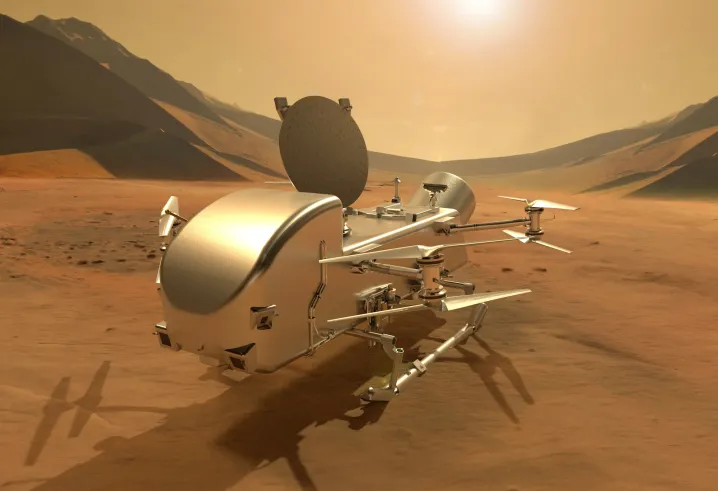NASA is taking what it’s learned from its groundbreaking Ingenuity Mars helicopter to create an even more complex flying machine to explore Titan, Saturn’s largest moon.
Whereas Ingenuity features a single rotor and a height of just 19.3 inches, Dragonfly has eight rotors and is the size of a small car.
A team of researchers led by the Johns Hopkins University Applied Physics Laboratory (APL) in Maryland has the advantage of Titan’s thick atmosphere, which will be easier to fly in than Mars’ considerably thinner atmosphere. Its low gravity will also help the flying machine to stay airborne.
In a recent update on the progress of Dragonfly’s development, NASA’s Patricia Talbert said the mission team has been paying regular visits to the space agency’s Langley Research Center in Hampton, Virginia, to test out Dragonfly’s flight systems inside the facility’s various wind tunnels, with gathered data helping it to refine the aircraft’s design.
On its latest trip to NASA Langley, the team tested a half-scale Dragonfly while focusing on two particular flight configurations: Dragonfly’s descent and transition to powered flight upon reaching Titan, and forward flight over the moon’s surface.
“We tested conditions across the expected flight envelope at a variety of wind speeds, rotor speeds, and flight angles to assess the aerodynamic performance of the vehicle,” test lead Bernadine Juliano of APL said in a release. “We completed more than 700 total runs, encompassing over 4,000 individual data points. All test objectives were successfully accomplished and the data will help increase confidence in our simulation models on Earth before extrapolating to Titan conditions.”

Dragonfly is NASA’s only mission to the surface of another ocean world. It’s expected to reach Titan in 2034 after launching from Earth in 2027. Titan bears some similarities to the very early Earth and scientists hope that with its suite of cameras, sensors, and samplers, Dragonfly will be able to make discoveries that tell us how life may have begun on our own planet.
“With Dragonfly, we’re turning science fiction into exploration fact,” said Ken Hibbard, Dragonfly mission systems engineer at APL. “The mission is coming together piece by piece, and we’re excited for every next step toward sending this revolutionary rotorcraft across the skies and surface of Titan.”
Editors’ Recommendations
NASA performs critical tests for Artemis V moon rocket
NASA shares its skywatching tips for September
NASA completes prelaunch test of its mega moon rocket
NASA ready for key launchpad test of its mega moon rocket
NASA’s new moon rocket to depart launchpad after failed test
Not so many moons ago, Trevor moved from one tea-loving island nation that drives on the left (Britain) to another (Japan)…
NASA calls off second try at moon rocket launchpad test

NASA has called off a second attempt at a launchpad test of its next-generation rocket destined for lunar missions as part of the Artemis program.
The so-called “wet dress rehearsal” would have involved NASA filling its powerful Space Launch System (SLS) with fuel before conducting a mock countdown.
Read more
Watch NASA test its autonomous mini rover ahead of lunar mission

NASA’s Perseverance rover, which is currently trundling across the surface of Mars, is about the size of a small car.
But recently the space agency has turned its attention to developing a smaller, shoebox-sized rover that it plans to send to the moon on an upcoming Artemis mission.
Read more
NASA is testing a 3D printer that uses moon dust to print in space

The Redwire Regolith Print facility suite, consisting of Redwire’s Additive Manufacturing Facility and the print heads, plates, and lunar regolith simulant feedstock that launches to the International Space Station. Redwire Space
When a Northrop Grumman Cygnus cargo spacecraft arrived at the International Space Station (ISS) this week, it carried a very special piece of equipment from Earth: A 3D printer that uses moon dust to make solid material.
Read more
>>> Read full article>>>
Copyright for syndicated content belongs to the linked Source : Digital Trends – https://www.digitaltrends.com/space/nasa-tests-dragonfly-drone-destined-for-titan/































